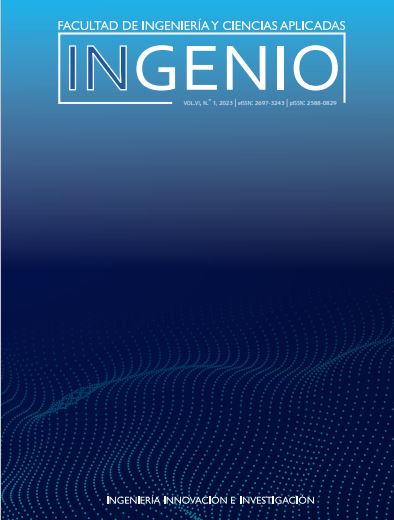Optimal Georeferenced Deployment of Charging Stations for Electric Vehicles in Distribution Networks Using a Trajectory-based Heuristic Model
Contenido principal del artículo
Resumen
The progressive increase in the consumption of fossil fuels and the constant efforts to reduce CO_2 emissions bring together the search for alternatives and the transport sector being one of the most dependent on fossil fuels and the cause of approximately 80% of the air pollution, the electric vehicle emerges as an alternative in mobility. That is why this article proposes a methodology for the optimal location of electric vehicle charging stations, given in a georeferenced distribution network scenario using a heuristic for the insertion of electric vehicles, taking into account energy consumption, travel and autonomy. developed based on real data, reducing the minimum location of charging stations. Evaluated in the distribution network of Santo Domingo-Ecuador, in a way that guarantees a technical and economic balance.
Descargas
Métricas
Detalles del artículo

Esta obra está bajo una licencia internacional Creative Commons Atribución-NoComercial-SinDerivadas 4.0.
Citas
Ministerio de Enérgia y Recursos Naturales no Renovables 2017, “Balance Energético Nacional 2017,” 2019.
A. Corral, F. Izurieta, V. Guayanlema, J. P. Díaz, H. Acurio, and P. Quintana, “Assessment opportunities for energy efficiency in Ecuadorian road transport Oportunidades de evaluación de eficiencia energética en el transporte terrestre en Ecuador,” vol. 84, no. 200, pp. 309–315, 2017.
J. Clairand, “Smart Charging for Electric Vehicle Aggregators considering Users ’,” vol. 3536, no. c, pp. 1–12, 2018, doi: 10.1109/ACCESS.2018.2872725.
M. M. Vazifeh, H. Zhang, P. Santi, and C. Ratti, “Optimizing the deployment of electric vehicle charging stations using pervasive mobility data,” Transp. Res. Part A, vol. 121, no. January 2017, pp. 75–91, 2019, doi: 10.1016/j.tra.2019.01.002.
Y. Fan, D. Mengnuo, G. Pei, Z. Zhang, L. Yingying, and W. Xiao, “The Influence on Distribution Network Planning and Investment Strategy of Power Grid Corp Under Electric Power System Reform,” in 2018 China International Conference on Electricity Distribution (CICED), 2018, pp. 2426–2430, doi: 10.1109/CICED.2018.8592014.
J. A. Sanguesa, V. Torres-sanz, P. Garrido, F. J. Martinez, and J. M. Marquez-barja, “smart cities A Review on Electric Vehicles : Technologies and Challenges,” pp. 372–404, 2021.
E. García, “Demand response systems for integrating energy storage batteries for residential users,” 2016.
W. Kempton, “ELECTRIC VEHICLES AS A NEW POWER ELECTRIC UTILITIES SOURCE FOR,” vol. 2, no. 3, pp. 157–175, 1997.
K. Schneider, C. Gerkensmeyer, R. Fletcher, and S. Member, “Impact Assessment of Plug-In Hybrid Vehicles on Pacific Northwest Distribution Systems,” pp. 1–6, 2008.
D. C. Published et al., “The Beginners Guide to Electric Vehicles ( EV ),” no. August, 2014.
K. Hu, J. Wu, and T. Schwanen, “Differences in Energy Consumption in Electric Vehicles : An Exploratory Real-World Study in Beijing,” vol. 2017, 2017.
F. Badin, F. Le Berr, H. Briki, M. Petit, S. Magand, and E. Condemine, “Evaluation of EVs energy consumption influencing factors ,” vol. 6, pp. 112–123, 2013.
X. Qi, G. Wu, K. Boriboonsomsin, and M. J. Barth, “Data-driven decomposition analysis and estimation of link-level electric vehicle energy consumption under real-world tra ffi c conditions,” Transp. Res. Part D, no. April, pp. 0–1, 2017, doi: 10.1016/j.trd.2017.08.008.
B. W. B. Auquilla, “ESTUDIO DE ESTRATEGIAS PARA LA INSERCIÓN DE VEHÍCULOS ELÉCTRICOS TIPO TAXI EN LA CIUDAD DE QUITO,” 2019.
G. Celli, F. Pilo, G. Monni, and G. G. Soma, “Optimal Multi-Objective Allocation of Fast Charging Stations,” 2018.
P. Frías and C. Mateo, “Evaluación del impacto de la integración del coche eléctrico en las redes de distribución de energía eléctrica,” pp. 56–61.
M. R. Rodríguez, “IMPACTO DE UN PARQUE VEHICULAR ELÉCTRICO EN LOS REQUERIMIENTOS DE RECONFIGURACIÓN DE LA RED DE DISTRIBUCIÓN DE LA CIUDAD DE SANTIAGO,” 2013.
M. Campaña and E. Inga, “Despliegue óptimo georreferenciado de estaciones de carga vehicular pública considerando capacidad de flujo y distancias máximas habilitantes Georeferenced optimal deployment for public vehicle charge station considering restrictions of capacity flow and maximal enablers distance,” vol. 15, no. 2, pp. 68–78, 2019.
M. Campaña, “Optimal Allocation of Public Charging Stations based on Traffic Density in Smart Cities,” 2019.
L. A. M. Maldonado, “Análisis técnico para la Implementación de Estaciones de Carga Rápida para vehículos eléctricos en la provincia de Galapagos,” 2020.
T. Carlos and H. Rojas, “Estaciones de Carga de Vehìculos eléctricos y su influencia en el funcionamiento de la red de distribución,” 2016.





